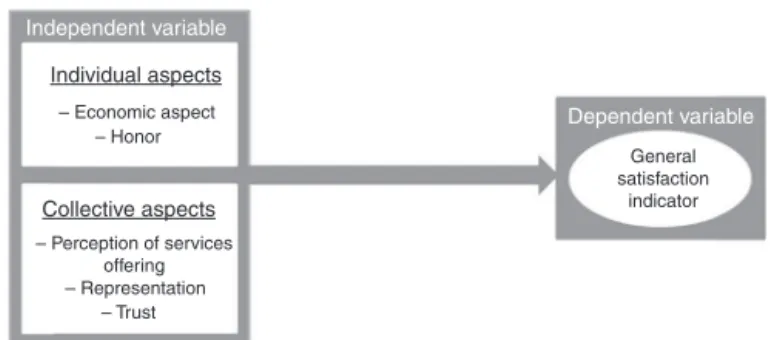Revista
de
Administração
http://rausp.usp.br/ RevistadeAdministração51(2016)246–254
Strategy
and
business
economics
Satisfaction
of
private
interest
associations’
members:
a
study
with
sugarcane
producers
in
Brazil
Satisfa¸cão
em
associa¸cões
de
interesse
privado:
uma
aplica¸cão
com
produtores
de
cana-de-a¸cúcar
no
Brasil
Satisfacción
en
asociaciones
de
interés
particular:
una
aplicación
con
productores
de
ca˜na
de
azúcar
en
Brasil
Luciano
Thomé
e
Castro
a,∗,
Priscilla
Mendes
Machado
b,
Marcos
Fava
Neves
a,
Roberto
Fava
Scare
aaBusinessDepartment,FacultyofEconomicsandBusinessofRibeirãoPreto,UniversityofSãoPaulo,RibeirãoPreto,SP,Brazil bBusinessGraduationProgram,FacultyofEconomicsandBusinessofRibeirãoPreto,UniversityofSãoPaulo,RibeirãoPreto,SP,Brazil
Received14December2014;accepted28February2016
Abstract
Thisstudyaimedtoidentifysatisfactionantecedentspresentedbysugarcaneproducerswiththeassociationstheybelongto.Itwasdevelopeda modelcomposedofsevendimensionswhichweregroupedintotwotypes:individualaspects(economic,networkingandhonor)andcollective aspects(perceptionofservices,representation,trustandrelevanceoftheassociation).Itwasperformedonequantitativeanddescriptivestudy, conductedthroughquestionnairesapplieddirectlytoproducers.550questionnaireswerecompletedand411ofthesewerevalid.Forthedata analysis,correlationandmultiplelinearregressionbetweenthevariableswereused.Theresultsshowedthatallsevenvariableswerepositively correlatedwithsatisfaction,however,onlyfiveofthemcomprisedthefinalmodelaftermultiplelinearregression:perceptionofservicesoffered, representation,trust,economicalaspectandhonor.Surprisingly,theresultsalsoshowedthatcollectiveaspectsaffectedmorethesatisfactionthan individualaspects.
©2016DepartamentodeAdministrac¸˜ao,FaculdadedeEconomia,Administrac¸˜aoeContabilidadedaUniversidadedeS˜aoPaulo–FEA/USP. PublishedbyElsevierEditoraLtda.ThisisanopenaccessarticleundertheCCBYlicense(http://creativecommons.org/licenses/by/4.0/).
Keywords: Associativism;Satisfaction;Predecessorsofsatisfaction;Collectiveaction
Resumo
Oobjetivodoestudofoiidentificaroselementospreditoresdasatisfac¸ãoapresentadaporprodutoresdecana-de-ac¸úcarcomasassociac¸õesde adesãovoluntáriaqueelesfazemparte.Foidesenvolvidoummodelocompostoporsetedimensõesaglomeradasemdoistipos:aspectosindividuais (aspectoseconômicos,estabelecimentodenovosrelacionamentosehonra)easpectoscoletivos(percepc¸ãodeservic¸os,representac¸ão,confianc¸ae relevânciadaassociac¸ão).Questionáriosforamaplicadosdiretamentea550produtoresedesses411foramválidos.Apartirdosdadoslevantados,
∗Correspondingauthorat:UniversidadedeSãoPaulo,FaculdadedeEconomia,Administrac¸ãoeContabilidadedeRibeirãoPreto,AvenidadosBandeirantes,
3900,14040-905RibeirãoPreto,SP,Brazil.
E-mail:ltcastro@usp.br(L.ThoméeCastro).
PeerReviewundertheresponsibilityofDepartamentodeAdministrac¸ão,FaculdadedeEconomia,Administrac¸ãoeContabilidadedaUniversidadedeSãoPaulo –FEA/USP.
http://dx.doi.org/10.1016/j.rausp.2016.06.001
foramfeitasanálisesdecorrelac¸ãoeregressolinearmúltiplaentreasvariáveis.Osresultadosidentificaramquetodasassetevariáveisdomodelo apresentamcorrelac¸ãopositivacomasatisfac¸ão,entretantoapenascincodelascompuseramomodelofinalapósaregressãolinearmúltipla: percepc¸ãodeservic¸osoferecidos,representac¸ão,confianc¸a,aspectoeconômicoehonra.Osresultadostambémmostraram,diferentementedo esperado,queosaspectoscoletivosinfluenciammais asatisfac¸ãodosprodutoresdo queosaspectosindividuais.Apresentam-seimportantes orientac¸õessobreapesquisaemassociativismoeagestãodeassociac¸ões.
©2016DepartamentodeAdministrac¸˜ao,FaculdadedeEconomia,Administrac¸˜aoeContabilidadedaUniversidadedeS˜aoPaulo–FEA/USP. PublicadoporElsevierEditoraLtda.Este ´eumartigoOpenAccesssobumalicenc¸aCCBY(http://creativecommons.org/licenses/by/4.0/).
Palavras-chave:Associativismo;Satisfac¸ão;Antecessoresdasatisfac¸ão;Ac¸ãocoletiva
Resumen
Elobjetivoenesteestudioesidentificarlosfactorespredictivosdesatisfacciónpresentadaporproductoresdeca˜nadeazúcarconrelaciónalas asociacionesdeafiliaciónvoluntariaalasquepertenecen.Sedesarrollóunmodelocompuestoporsietedimensionesorganizadasendostipos: aspectosindividuales(aspectoseconómicos,establecimientodenuevasrelacionesyhonor)yaspectoscolectivos(percepcióndelosservicios, representación,fiabilidadyrelevanciadelaasociación).Seaplicaroncuestionariosdirectamentea550productores,delosqueresultaron411 válidos.Apartirdelosdatosrecolectados,serealizaronanálisisdecorrelación yregresiónlinealmúltiple.Losresultadosmostraronquelas sietevariablesdelmodelosecorrelacionanpositivamenteconlasatisfacción,sinembargo,sólocincodeellascompusieronelmodelofinaltras llevarseacabolaregresiónlinealmúltiple:percepcióndelosserviciosofrecidos,representación,fiabilidad,aspectoeconómicoyhonor.Además, losresultadosindicaron,adiferenciadeloesperado,quelosaspectoscolectivosafectanmáslasatisfaccióndelosproductoresquelosaspectos individuales.Sepresentanimportantesorientacionessobrelosestudiosenasociativismoylagestióndeasociaciones.
©2016DepartamentodeAdministrac¸˜ao,FaculdadedeEconomia,Administrac¸˜aoeContabilidadedaUniversidadedeS˜aoPaulo–FEA/USP. PublicadoporElsevierEditoraLtda.Esteesunart´ıculoOpenAccessbajolalicenciaCCBY(http://creativecommons.org/licenses/by/4.0/).
Palabrasclave: Asociativismo;Satisfacción;Factorespredictivosdelasatisfacción;Accióncolectiva
Introduction
Theassociationsbetweenproducersof sugarcaneinBrazil areformedbytheguildofproducersbyproducingregions.As anexample, insouth-centralBrazil, thereare 31associations withabout18,000sugarcaneproducers.
Untiltheearly1990s, the current regulationsinthe sector forcedtheparticipationoftheproducersinassociations.Withthe deregulation,theproducerswouldbefreetojoinvoluntarilythe associationtheypreferred,regardlessoftheregioninwhichthey arelocated,beginningtocontributefinancially.Otherchanges havetakenplaceinthesectorwiththederegulationandtheendof statesupportapparatus.Fromthatmomenton,therelationship oftheactorsthroughtheassociationswasexpandedinorderto increaseparticipationinthepoliticalprocess,andthemembers ofassociationshadnewdemands,searchingforcostreduction andproductdifferentiation(Mello&Paulillo,2005).
Giventheimportance of theassociation for producersand thefreedomtojointheassociationstheylikedthemost,the ben-efitsprovidedbythemcandefinetheirexistenceandstability. Thisis becausethe voluntarynatureof associationspositions theirmembersasclients,demandingfor specificservicesand choosingtoremainboundtoitbyweighingthecostsand bene-fitsarisingfrommembership.Thesecostsaremainlyrelatedto entrepreneurs’timeofopportunitycostsandcapitalopportunity costsfor the maintenanceof theassociation. Thus,managers mustseektodrawattractiveactionsinordertoensurethe con-tinuedparticipationofitsmembers(Conejero,2011;Nassar& Zylbersztajn,2004).
Associationscanprovide arange ofindividual and collec-tivebenefits, aswellasfacilitatethegrowthof economicand
social relations among their members. The degree in which associationsprovidedesiredbenefitstothememberscanvary considerably,whichultimatelyaffectstheirparticipationin asso-ciationactivitiesandenablesmanymemberstobedisappointed withthebusiness.Therefore,animportanttaskforthelong-term sustainabilityofbusinessassociationsistounderstandthe deter-minantsofadherenceofmembersatisfaction(Newbery,Sauer, Gorton,Phillipson,&Atterton,2013).
Inthiscontext,thispaperaimstoidentifypredictorelements of satisfaction presented by the producers of sugarcanewith theassociationstheybelong.Inordertodothis,amodel was developedbytheauthorsforasubsequentexaminationthrough statistical analysis. Wewillpresent below the factorsstudied leadingtheoristsofthesubjectandthatwereaddedtothemodel oftheresearch.
Satisfactioninthecontextofassociativism
Sincetheexistingrelationshipbetweenmembersand asso-ciation is similar to the relationship between customer and company, the concept ofsatisfaction developedbymarketing theoristsinthebusinesscontextcanbeappliedinthiscontext.
Oliver(1996)arguesthatthereareplentyofconceptsfor satis-faction,whichhindersasimpledefinitionforthatterm.However, he presents its own definition, stating that satisfaction is the judgment thatacharacteristicof theproductor serviceor the productor serviceitself provided(oris providing)apleasant levelofachievementrelatedtoconsumption.Anotherdefinition isgivenbyKotler(2000,p.58),statingthatsatisfaction“[...]
comparisonoftheperformance(orresult)obtainedfroma prod-uctinrelationtobuyer’sexpectations”.Kotler(2000)assertsthat satisfactionisachievedwhentheperceivedresultisequaltoor greaterthantheexpectationspresentedbythebuyer.
Importingtheconceptofsatisfactiontothecontextof associ-ation,itcanbesaidthatthemembers’satisfactionoccurswhen theygetresultsequaltoorhigherthanexpectedbybeingpartof thegroup.Thus,itcanbesaidthatthereasonsthatlead compa-niesorindividualstobecomepartoftheassociationarethesame reasonsthatwillmakethemstayifthesefactorsaresufficiently metandmatched.
Involuntaryassociationssystem,themotivationofmembers andtheirinterpretationsofassociativitymaintainsthelogicof membership,beingadeterminantfactorofsuccessorfailureof theassociation(Bennett&Ramsden,2000).Previousresearch hasidentifiedanumberofreasonsformembershipinbusiness associations, highlighting the following aspects: the acquisi-tion of information, accessto specificservices,lobbying and self-regulation,representationofcollectiveinterests,marketing andgroup buying opportunities,socialbenefits, compliments andaccreditation(Bennett&Ramsden,2007;Newberyetal., 2013).
The analysisof the motivation formembership of compa-nies andindividuals canbe made inthe light of the logicof servicesandofcollectiveactivity.Thelogicofservicesmeans thatassociationshavetorespondtotheindividualandspecific needsanddemandsofthemembers,causingtheassociationto resembleabusinessservicescompany.Ontheotherhand,the logicofcollectiveactivityfocusesontheassociation’srolein actingonbehalfofall,oratleastthemajority,orinthe inter-estsofitsmembers.Thelogicofcollectiveactivity,particularly inthe search for representational influence, leadassociations toseekaratioashighaspossibleofmembersofitssectoror relevantareaofinterest,inordertomaximizeitslegitimacyto speakon thesector’sname as awhole(Bennett &Ramsden, 2000).
Wethennotethatmembershiptoanassociationisgivenboth forreasonsofindividualaspectsandcollectiveaspects. Accord-ingtoBennettandRamsden(2007),associationsareabletooffer someuniqueblendsofindividualbenefitstailoredtoniche strate-gies,andcollectivebenefitsarisingfromsharedinformationand opportunities.
TheseaspectswerepresentedbyOlson(1971)whenstudying collectiveactions,statingthat,inlargegroups,bothcollective andindividualinterestsshouldbepromoted.Unlikethesmall groups,collectiverewardsarenotenoughtoattractparticipants inlargegroups.Thus,itisnecessarythatthemembers under-standtheindividualbenefitsthattheycangetbybeingpartof agivengroup.Thatisbecause,accordingtoOlson(1971),the largerthegroup,thefartheritgetstogetevenanidealsupply of anycollectivegood,andtheless probabilityhasthe group toactinordertoobtainevenaminimalamountofsuchgood. Thus,thelargerthegroup,thelessitpromotesitscommon inter-ests;consequently,anadditionalincentiveshouldbegivenfor companiesorindividualstobecome partofit.Basedonthese aspects,the followinghypotheses havebeen proposedbythe research:
Hypothesis 1. Individual benefits provided to producers through theassociation influenceinthe satisfactionperceived bythemembers.
Hypothesis 2. Collective benefits provided to producers through theassociation influenceinthe satisfactionperceived bythemembers.
Both individual andcollectivebenefits offered by associa-tionscoverdifferentaspectsthatcancontributetothesatisfaction of participantsin thegroups. Below, we presentthe different typesofindividualandcollectivebenefitsofferedbythe associ-ationstotheirmembers.
Individualbenefits
Individual benefits are thoseprovided individually to par-ticipants,sothatthebenefitreceivedisdifferentforeachone. Althougheconomicincentivesareofgreatimportanceto mem-bersof associations,socialandpsychologicalaspectssuch as prestigeandrespectarealsorelevanttothem.Somescholarsof organizationaltheorypointoutthatthesocialincentivesshould be analyzedinthe samewaymonetaryincentivesare (Olson, 1971).Thus,thesetwokindsofbenefitswillbepresentedherein.
Economicaspects
Economicaspectsisoneoftheindividualbenefitsprovided byassociationstotheir members.AccordingtoOlson(1971), thegroupincreasingprovidesthecostreductionassignedtoeach participantinordertoincreasethe benefitsavailable tothem. Moreover,accordingtoBennett andRobson(2001),thiscost reductioncomesprimarilyfromsavingsintransactioncostsand economiesofscaleprovidedbyassociationsfromthespecific services offeredbythem.Thus,thegainof expertisethat the association mayhaveintheexecutionofcertainservicesmay representafinancialgaintothemembersand,inaddition,there ispotentiallyatransactionalefficiencyofthememberwiththe associationthatdoesnotmotivatethedevelopmentonitsowna givenservice;inotherwords,itismoreworthwhiletohirethe associationthantodeveloptheservicesonitsown(Williamson, 1985).Thus,itcanbesaidthattheeconomicbenefitsofferedby themarisefromtheindividualandcollectiveservicesavailable tomembers.
Basedontheinterpretationthatingeneralfinancial returns affectthemotivationandsatisfactionofindividuals,we devel-opedthefollowingresearchhypothesis:
Hypothesis1a. Themonetaryreturns availabletoproducers through theassociationinfluencethesatisfactionperceivedby themembers.
Contacts
be understood as environments with a collective action and arecapableofgeneratingfactorssuchassocialcapital, collec-tivelearningandreputation,providinggreatercompetitiveness formembers(Barra,Oliveira,&Machado,2007).Once asso-ciations can be construed as business networks, the benefits suggestedbyliteraturemaybetransportedtonetwork associa-tions.Amongthebenefits,thereistheestablishmentofcontacts and important relationships through the existing relationship withtheassociationanditsmembers.AccordingtoHákansson andSnehota (1997),the relationship betweentwo actors can changethewaytheyareperceivedbyotherexistingactors.This perceived identity affects the possibilities of acting and may contributetobuildingnewrelationships.Thus,thelinks devel-opedbetweencompaniesinbusinessrelationshipsaffecttheir behaviorandidentities.
Basedontheimportanceofbuildingrelationshipsand impor-tantcontactsforthedevelopmentofcompanies,thefollowing hypothesiswasdeveloped:
Hypothesis1b. Thepossibilityofbuildingcontactsand impor-tantrelationshipsforproducersthroughassociationinfluencethe satisfactionperceivedbythemembers.
Honor
Thehonoraspectpresentedhereislinkedtothefeeling gen-eratedintheassociations’memberstobepartofagroup.Thus, whentheyareidentifiedaspartofaparticulargroup,thisfeeling isdevelopedbythemembers.
Someresearcheshavediscussedtherelationshipbetweenthe identificationoftheactorswiththegroupofwhichtheyarepart andtheactiveparticipationofthemincollectiveactions devel-opedwithinthe group.Ithasbeenobservedthat thoseactors havingahigherdegreeofidentificationwiththegroupare intrin-sicallymoremotivatedtoparticipateincollectiveactionsandare morecommittedtothegoalsandinterestsof thegroup.Thus, totheseparticipants,concernforthecollectivepurposes over-comesindividual goals.In contrast, participantswhoidentify lesswiththegroupsofwhichtheyarepartarelesswilling to contributetotheuniquegoalsofthegroup,beingwillingto com-mitwiththecollectivegoalsthatare,infact,theirownindividual goals(VanZomeren,Spears,&Leach,2008).Oncethis identi-ficationwiththegroupcaninfluencethelevelofparticipationof members,itispossiblethatitmayalsoaffecttheirsatisfaction. Also,sincethehonorwasestablishedhereasthefeeling gener-atedbymembershipintheassociation,thefollowinghypothesis wasformulated:
Hypothesis1c. Thesenseofhonorprovidedbymembership intheassociation influencesthe satisfactionperceived bythe members.
Althoughtheassociationsallowthescopeofpurelypersonal individualinterests,acharacteristicfeatureofthemistopromote thecommoninterestsofthegroup;thereforeitisessentialthat theydevelopthisfunction(Olson,1971),asdevelopedbelow.
Collectivebenefits
Collectivebenefitsarethosecommontoallparticipants,so thatnomemberofthegroupcanbeexcludedandnorbedenied thesatisfactionprovidedbythem.Wepresentbelowfourtypes ofcollectivebenefits:services,representativeness,trustand rel-evance of associations. Nassar and Zylbersztajn (2004) also showed that associations formed by large and homogeneous groups of memberstend tohave agreater range of common benefits.
Perceptionofservicesupply
AccordingtoBennettandRamsden(2000),themainreason thatleadsmemberstojointheassociationisaccesstoservices, be theyspecificor collective. Similarly, themain reasonthat leadmemberstoleavethe associationsis dissatisfactionwith theservicesofferedbythem.AsurveyconductedbyNewbery etal.(2013)showedthatassociationsbasedonservicesprovide higher levels of satisfaction to their members. According to
Bennett andRobson(2001),the mainservicesofferedby the associationsconsistofcollectiveandself-regulationfunctions. However,otherlow-costservices,lowfrequencyandlow dura-tionarealsoofferedtoparticipants.Theauthorspointoutthat manyoftheselessprominentservicesareattractivetonew mem-berswhoseethemasservicesthatcanbeusedifonedaythey needthem.Theauthorsdefinethisfactorasakindofinsurance rate,onceitwillbeavailabletomemberswhenneeded.
As quoted in the text on individual aspects, the services offeredbyassociationsarethemainsourcesofeconomic bene-fitsofthemembers.Butherewenotemphasizethesatisfaction displayedbytheparticipantstotheservicesusedbythemand theirreturns,buthowmuchtheybelievealltheservices avail-able tothem are in accordance withthe needs of thosewho are part of the association. Thus, all the services provided arehighlighted,including theless frequentones, analyzedby
BennettandRobson(2001).Basedontheseaspects,the follow-ingresearchhypothesesweredeveloped:
Hypothesis2a. Perceptionoftheserviceofferingsavailableto producersinfluencesthesatisfactionperceivedbythemembers.
Representativeness
Despite the importance of the representativeness of asso-ciations, studies have shown that it is not the main reason of affiliationfor companies or individuals. As shown above, themainmotivation ofthe participantswould betheservices offered.Nevertheless,representationisalsoasourceof motiva-tionandsatisfactionofmembersandthereforeweformulated thefollowingresearchhypothesis:
Hypothesis2b. The representativenature of theassociation influencesthesatisfactionperceivedbythemembers.
Trust
BennettandRamsden(2000)arguesthatassociationsenjoy acertain contextof trustby providinga specificrelationship marketwithitsmembers,whichisdifferentfromotherbusiness service providers. Thisallowsorganizations to connect more closelytotheir“customers”thaninarelationshipofpuremarket.
Koutsou,PartalidouandRagkos(2014)highlightthefactthat recentresearchhaslinkedconfidencetocollectiveactionand cooperationbetween membersof groupsfor mutualbenefits. ThisaspectisunderscoredbyDurston(2003,apudBarraetal., 2007) by statingthat the sharecapital resulting from certain socialrelationships provide trust, reciprocityandcooperation betweenthoseinvolved,andcangenerategreaterbenefittothose whohaveit.
According Koutsou et al. (2014), the existence of trust betweenmembersandmemberswiththe institutionof which they are part provides the network breakthrough for collec-tiveaction,influencingthedevelopmentofthegroup.Fromthe authors’pointofview,thereisadistinctionbetweennetworks and collective actions. While networks are characterized by interactionsandconviviality,collectiveactionsarecharacterized bythesynergiesdevelopedtoachievethecommongoals.
Alsoaccordingtotheauthors,thistrustreferstooneofthe features provided by the social capital. This aspect is high-lightedbyPutnam(2005,p.177)bystatingthatsocialcapital refersto“[...]thecharacteristicsofsocialorganization,suchas
trust,normsandsystems,contributingtoincreasetheefficiency ofsocietybyfacilitatingcoordinatedactions”.Oncethattrust affectscoordinationandtheinvolvementofmembers associa-tions,andthisinvolvementcouldaffectthesatisfactionfeltby them,itwedevelopedthefollowingresearchhypotheses:
Hypothesis2c. Thetrustfeltbymembersregardingthe asso-ciationinfluencesthesatisfactionperceivedbythemembers.
Relevanceoftheassociationforproducersandforthe sector
Theassociationreportedlyhasaveryimportantroleforits membersandthesectorasawhole,since,fromthebeginning ofitsformation,ithasthepurposeofactingintheinterestsof itsmembersbyprovidinginformation,supportingnegotiations withsuppliers andbuyersof products of its members, quali-fyingmembersandtheirlabor,amongotherpotentialservices (Zylbersztajn&Farina,1999).
Rao,Morrill,andZald(2000)highlight,however,thatwhen decisionstakenbyassociationshinderthedistributionof ben-efits amongits members,the affected participantsattempt to
Independent variable
– Economic aspect
– Perception of services offering – Representation
– Trust – Relevance
Individual aspects
Collective aspects
– Contacts
– Honor General
satisfaction indicator
Dependent variable
Fig.1.Modeldevelopedtodeterminethesatisfactionofproducerswiththe independentvariablesandthedependentvariable.
influencethedecisionandlegitimizeneworganizationalforms. Theassociationsarethenaffectedbythecostofinfluence,since the collective actionfails due to social movements initiated. Thus,therelevancetheyrepresentdecreasesandanenvironment isdevelopedaroundaneworganizationalform.
Basedonthesefactors,wecaninterpretthatwhilethe asso-ciationtakesactionaccordingtothe needsofits participants, theyattributesomeimportancetoitandshowastateof satisfac-tionwiththerelationship.Thus,thefollowinghypothesiswas established:
Hypothesis2d. The importance giventotheassociation by producersinfluencethesatisfactionperceivedbythem.
A study by Cafferata (1979) analyzed the satisfaction of the membersof anassociationof professionalsinthelight of exchange theories(Blau,1964;Homans,1961)andcollective action (Olson, 1971). According to the author, the exchange theory suggests that peoplewill be satisfied withthe organi-zation when they reach the goals setby their members. The theoryofcollectiveactionsuggeststhatsatisfactionisaffected by participation in activities that provide particular benefits. Thus,thestudybyCafferatashowedgreateremphasison indi-vidualaspectsthanoncollectiveaspects.Similarly,Melloand Paulillo(2005)emphasizethattheactionsofparticipantsof sug-arcaneassociationsinthestateofSãoPauloaremorefocusedon individualissuesthancollectiveonesasaresultoftheexisting culture.
Basedonthisemphasisbytheauthorsontheindividualnature ofbenefitsofferedbytheassociations,inordertopointoutthat thesebenefitsattractmoremembersthanthecollectivebenefits, wedevelopedathirdhypothesisfortheresearch:
Hypothesis3. Theindividualbenefitsperceivedbymembers influencemorethesatisfactionfeltbythemthanthecollective benefits.
Table1
Researchhypotheses.
Hypothesis1 Individualbenefitsprovidedtoproducersthroughthe associationinfluencethesatisfactionperceivedbythe members.
H1a–Themonetaryreturnsavailabletoproducers throughtheassociationinfluencethesatisfaction perceivedbythemembers.
H1b–Thepossibilityofbuildingcontactsandimportant relationshipsforproducersthroughassociation influencethesatisfactionperceivedbythemembers. H1c–Thesenseofhonorprovidedbymembershipin theassociationinfluencesthesatisfactionperceivedby themembers.
Hypothesis2 Collectivebenefitsprovidedtoproducersthroughthe associationinfluenceinthesatisfactionperceivedbythe members.
H2a–Perceptionoftheserviceofferingsavailableto producersinfluencesthesatisfactionperceivedbythe members.
H2b–Therepresentativenatureoftheassociation influencesthesatisfactionperceivedbythemembers. H2c–Thetrustfeltbymembersregardingthe associationinfluencesthesatisfactionperceivedbythe members.
H2d–Theimportancegiventotheassociationby producersinfluencethesatisfactionperceivedbythem.
Hypothesis3 Theindividualbenefitsperceivedbymembersinfluence morethesatisfactionfeltbythemthanthecollective benefits.
Methodology
Toachievetheresearch’sproposedscope,wemadea quan-titativeanddescriptivestudy,usingthequestionnaireasadata collectioninstrument.Thequestionnaireconsistedofquestions regardingtheprofileoftherespondentsandissuesconcerning theproposedresearchmodel.Thus,theissueswererelatedto thesevendimensionspresentedaspredictorsofsatisfactionof membersandtotheir generalsatisfaction.Weused five-level Likert scalestoverify the behavior of producersbefore each oftheindependentvariablesaddressedintheresearchandalso forthe dependent variableinvestigated,with1 corresponding tostronglydisagreeand5for stronglyagree.Thescalesused wereadaptedforusewithinthecontextofthestudy,asshown inTable2.
Questionnairesweregiventosugarcaneproducersandfilled while attending events for the sector. Questionnaires were proposedover19events,leadingtothefinal550completed ques-tionnaires.Ofthistotal,139incompletequestionnairesshowing noresponseinthevariablesthatwouldbeusedlaterwere elim-inated.
Thehighrateofincompletequestionnairesmaybeduetothe difficultyoftheproducersinterpretthequestionsasked.Thus, acaveat is made, because of the possibility of a bias in the formofthequestionnaires.Possibly,ifatrainedinterviewerhad conductedthesearch,thenumberofincompletequestionnaires would be lower.Afterthe elimination of partially completed questionnaires,411validquestionnaireswereleft.
Among the respondents, there are producers of different states andcities, distributedin fourstates (São Paulo,Minas Gerais,MatoGrossoandAlagoas)and81cities.Another impor-tantaspectisthattheproducersalsohavedifferentsizes,ranging between2and70,000haofareaforplantingcane,and82.7% of them havean area smaller than 1000ha. In addition,411 producerswhoparticipatedinthesurveyaredistributedamong 21associations.Thesefactorsindicatetheheterogeneityofthe sampleused,asbefitstheprofileofthecaneproducersinBrazil. Fromthe411validquestionnaires,datawasprocessedand statisticalanalysiswasmadeusingSPSSsoftware.Correlation andmultiplelinearregressiontestswereperformed,aspresented inthenextsection.
Results
Inordertoverifytherelationshipoftheindependentvariables andthedependentvariable,thecalculationsofcorrelationsand multiplelinearregressionwereperformed.Thecalculatedvalues ofthecorrelationsareshowninTable3.Theresultsshowthatall investigatedvariableshavesignificantpositivecorrelationwith theindicatorofoverallsatisfaction,thelevelof α=0.01.This
indicatesthatforallvariables,theincreaseineachoneofthem representsanincreaseinoverallsatisfactionindicatorproducers. Amongthevariables,the trustintheassociation presented byproducerswastheonethatshowedthestrongestrelationship withtheirsatisfaction(r=0.717).Subsequently,the representa-tivenatureoftheassociation(r=0.698)andthemonetaryreturns available toproducersthrough association(r=0.646)showed moderatevaluesofcorrelationwithsatisfaction.Thenthe per-ception ofservice offeringsavailable toproducers(r=0.606) andthehonorthatproducersfeelforbeingpartoftheassociation (r=0.604)showedvaluesofclosecorrelation.Thepossibilityto buildcontactsandrelationshipsimportantforproducersthrough association(r=0.567)alsoshowedmoderatecorrelationvalue. Finally,theassociationrelevancefeltbyproducersbothforthem andforthesectorasawholepresentedthelowestcorrelation coefficient withsatisfaction(r=0.407)andwas the onlyone withavaluebelow0.5.
Calculation of the average of the correlations presented withinthegroupsclassifiedbytheresearchshowsthatindividual aspects(r=0.606)andcollectiveaspects(r=0.607)have simi-larvaluesofcorrelationwithoverallsatisfactionrate.However, standarddeviationofthecollectiveaspectswas0.142,whileof theindividualaspectswas0.040,indicatingagreaterdispersion ofthevaluesofthecollectiveaspects.Thisshowsthatthe vari-ablesthatmakeuptheseaspectsarelinkedtothesatisfactionin amoredistinctwaywhencomparedbetweenthem.
Table2
Developedscalesandtheoreticalframework.
Dimensions Scales Authors
Economicaspects Ifeeleconomicallysatisfiedwiththe
association.
Olson(1971)andBennettandRobson (2001)
Contacts Totakepartintheassociationallowsmeto
makeimportantcontacts/relationship.
HákanssonandSnehota(1997),Barraetal. (2007),andBennettandRamsden(2007).
Honor Formeitisanhonortobepartofthe
association.
VanZomeren,Spears,andLeach(2008).
Perceptionofserviceofferings Theservicesofferedbytheassociationmeet theneedsofproducers.
BennettandRobson(2001),Bennett(2010), andNewberyetal.(2013).
Representation Ifeelfullyrepresentedbytheassociation. MelloandPaulillo(2005),Perry(2012),and
North(1994).
Trust Itrusttheassociationasgoodexecutorofhis
role.
Bennett(2000),Koutsouetal.(2014),and
Putnam(2005).
Relevance Iftheassociationceasedtoexisttherewould
belossesforproducersandthesector.
Raoetal.(2000)andZylbersztajnand Farina(1999)
Overallsatisfactionindicator Overall,Iamsatisfiedregardingthe association.
Bennett(2000),Cafferata(1979),andOliver (1996)
Table3
Correlationoftheindependentvariableswiththeoverallsatisfactionrateofproducers.
Economicaspect Contacts Honor Perceptionofservices Representation Trust Relevance
PearsonCorrelation 0.646** 0.567** 0.604** 0.606** 0.698** 0.717** 0.407**
Significance 0.000 0.000 0.000 0.000 0.000 0.000 0.000
Relevance 411 411 411 411 411 411 411
**Correlationissignificantforα=0.01.
Table4
Multiplelinearregressionofindependentvariableswiththeoverallsatisfactionrateofproducers.
Model Non-standardizedcoefficients Standardizedcoefficients T Significance
B Standarddeviation Beta
(Constant) 0.277 0.156 1.775 0.077
Economicaspect 0.096 0.044 0.107 2.185 0.029*
Contacts −0.018 0.043 −0.019 −0.416 0.678
Honor 0.092 0.046 0.094 2.008 0.045*
Perceptionofservices 0.231 0.040 0.221 5.840 0.000**
Representation 0.176 0.049 0.198 3.616 0.000**
Trust 0.354 0.045 0.362 7.791 0.000**
Relevance −0.286 0.395 −0.013 −0.683 0.223
* Significantforα=0.05. **Significantforα=0.01.
The results of multiple linear regression showed that two oftheindependentvariablesraisedbythestudy werenot sig-nificant. The possibility of creating important contacts and relationshipswithotheractorsandtherelevanceofthe associ-ationidentifiedbytheproducersdidnotindicatehavingcausal relationwiththesatisfactionfeltbythem.Thus,hypothesesH1b
andH2dwererejected.
Asfortheothervariables,theyshowedsignificantamounts, causing the hypotheses H1a, H1c, H2a, H2b and H2c to be
accepted.Itisnoteworthythatthevariablesrelatedtoservice, representationandtrustweresignificantforα=0.01,whilethe
economicaspectandthehonorweresignificantforα=0.05.
Thus,notallthevariablesraisedbythestudyareantecedents ofthesatisfactionofproducers.Onlythevariablesservice, rep-resentation,trust, economicaspectandhonorshowedtohave
causal effectwiththe dependent variable. Themodel consid-eringonlythevariablesthatpresentedastatisticalsignificance showedR2=0.639,indicatingthat63.9%ofthevariabilityofthe dataobtainedforthesatisfactionofproducersisexplainedby thismodel.Basedontheseresults,wereformulatedthemodel, asshowninFig.2.
Independent variable
– Economic aspect
– Perception of services offering – Representation
– Trust
Individual aspects
Collective aspects
– Honor
General satisfaction
indicator
Dependent variable
Fig.2.Adjustedmodelwiththeindependentvariablesandthedependent vari-able.
variables, its degreeof causality was lowerthanonly oneof them.
Finally,itisalsoimportanttomakeafinalrelationbetween thetwogroupsclassifiedintheresearch.Byobservingthe vari-ablesthatmakeupthegroups,itisclearthatthetwovariablesthat werenotpartofthefinalmodelbelongeachtooneofthegroups. However,thefactthattwovariablesofeachpartwererejected didnotleadtorejectionofthegeneralhypotheses1and2,sothat H1andH2hypotheseswereaccepted.Furthermore,althoughthe
othertwovariablesofthegroupofindividualaspectspresented asignificance,theybothobtained the levelof α=0.05,while
inthecollectivegroupallaspectsweresignificantatthelevel ofα=0.01.Thisshowsthatthecollectiveaspectsaffectmore
theoverallsatisfactionofproducersthantheindividualaspects; thus,hypothesisH3wasrejected.
Managerialimplication
Theidentificationofvariablesthataffectthesatisfactionof producersisof greatvaluetomanagersofassociations.From themomentthattheassociationshavebecomeofvoluntary con-tribution,theyhadtoworkinordertobeattractivetoproducers. Thus,thisresearchshowsapossiblepaththatcanbefollowed bymanagerstomakemembersmoresatisfiedwithparticipation intheseassociations.
Therefore,themanagers mustidentifytheservices consid-eredbyitsmembersasmorerelevantandnecessaryforthem. Eveniftheseservicesarenotoftenused,theassociationmust strengthenitspositionaboutservicesinaclearandstrengthened wayinexternalcommunication.Theymustalsohaveahighlevel ofrepresentationanddemonstratethistoitsparticipants.Again, theassociationneedstocommunicatevery wellits actionsof representativenature.
Itisalsoimportantthattheyprovideconfidenceandthatthey areabletodevelopasenseofbelongingandhonorinits mem-bers.Relationship techniques associated with database tools, thestrengtheningoforganizationalculturethroughthe organi-zationalritualsarewelcomeexamplesfromthecorporateworld thatgointhisdirectionandthatmaywellbeimplementedinthis context,possiblymoreeasilybecauseofthesymbolic dimen-sionthatthe associationhasfor producersorfor thecity and region.Lastbutnotleast,itiscrucialthattheassociation pro-videssatisfactoryeconomicbenefitstoitsmembers,i.e.,istruly effectiveintheservicesitintendstodevelop,takingadvantage
ofthescaleitpossessesandbeingabletotaketheseservicesto abiggernumberofassociatedproducersinterestedinthem.
Conclusion
Thisstudywasabletoidentifythepredecessordimensions andpredictorsofsatisfactionof theproducersconcerning the associations to which they belong. From the multiple linear regression analysis of the variables identified in the baseline withtheoverallsatisfactionrate,fivedimensionscomposedthe finalmodel:perceptionofservicesoffered,representation,trust, economicaspectandhonor.
Asshownatthebeginningofthework, satisfactionof the membersoftheassociationsareconsequencesofthereachof individualandcollectivebenefitsconsistentwiththeir expecta-tions.Accordingly,aspectshavebeenidentifiedforbothtypes ofbenefits.However,thecollectiveaspectshadgreaterimpact onsatisfactionofthemembersthantheindividualones,unlike expectedbeforetheachievementoftheresearch.Both dimen-sionsthat make upthe individualaspects – economicfactors and honor felt by the members for being part of the associ-ation– showed less significancewhen comparedtothe other dimensions.
Anotheraspecttobeconsideredisthat,sinceitwasidentified that63.9%ofthevariabilityofthedataobtainedforthe satis-factionofproducersisexplainedfromthemodelcomposedof fivedimensions,itappearsthatthereareotherissuesthatcan causesatisfactionofproducers.Thus,futureresearchmaytryto determineothersourcesofsatisfactionamongthem.
Future research may also try to identify moderating vari-ablesthatmayinfluencetherelationshipbetweenthedimensions foundhereandsatisfaction.Internalfeaturesofassociationsand producers,aswellascharacteristicsoftheexistingrelationship, canbeoneoftheaspectsthatcancomposethesevariables.
Conflictsofinterest
Theauthorsdeclarenoconflictsofinterest.
Acknowledgment
AuthorswouldliketothankFAPESPduetothefinancial sup-portprovidedtothisresearchprojectaswellastheinstititutional supportfromOrplana(Organizac¸ãodosPlantadoresdeCanada RegiãoCentro-SuldoBrasil).
References
Barra,G.M.J.,Oliveira,V.C.S.,&Machado,R.T.M.(2007).Opapeldas associac¸õesdeinteresseprivadonomercadocafeeirobrasileiro.Revistade GestãoUSP,14(2),17–31.
Bennett,R.J.,&Ramsden,M.(2000).Thelogicofmembershipofsectorial businessassociations.ReviewofSocialEconomy,58(1),17–42.
Bennett,R.J.,&Ramsden,M.(2007).Thecontributionofbusinessassociations toSMEs.InternationalSmallBusinessJournal,25(1),49.
Blau,P.(1964).Exchangeandpowerinsociallife.NewYork,NY:Wiley.
Cafferata,G.L.(1979).Memberandleadersatisfactionwithaprofessional association:Anexchangeperspective.AdministrativeScienceQuarterly, 24,472–483.
Conejero,M.A.(2011).Planejamentoegestãoestratégicadeassocia¸cõesde interesseprivadodoagronegócio:Umacontribui¸cãoempírica(Doctoral’s thesis).SãoPaulo:FaculdadedeEconomia,Administrac¸ãoeContabilidade, UniversidadedeSãoPaulo.
Durston,J.(2003).Capitalsocial:Partedelproblema,partedelasolución,su papelenlapersistenciayenlasuperacióndelapobrezaenAméricaLatina yelCaribe.InR.Atria,&M.Siles(Eds.),Capitalsocialyreduccióndela pobrezaenAméricaLatinayelCaribe:Enbuscadeunnuevoparadigma(pp. 147–202).SantiagodoChile:ComissãoEconômicaparaAméricaLatinae oCaribe;UniversityofMichiganPress.
Hákansson,H.,&Snehota,I.(1997).Analyzingbusinessrelationships.InD. Ford(Ed.),Understandingbusinessmarkets.London:TheDrydenPress.
Homans,G.C.(1961).Socialbehavior:Itselementaryforms.NewYork,NY: Harcourt,BraceandWorld.
Kotler,P.(2000).Administra¸cãodeMarketing.SãoPaulo,SP:PrenticeHall.
Koutsou,S.,Partalidou,M.,&Ragkos,A.(2014).Youngfarmers’socialcapital inGreece:Trustlevelsandcollectiveactions.JournalofRuralStudies,34, 204–211.
Mello,L. F.,&Paulillo, F.O.T. (2005).Metamorfoses da rededepoder sucroalcooleira paulista e desafiosda autogestão setorial.Agric, 52(1), 41–62.
Nassar,A.,&Zylbersztajn,D.(2004).Associac¸õesdeinteressenoAgronegócio Brasileiro.RevistadeAdministra¸cão,39(2),141–152.
Newbery,R.,Sauer,J.,Gorton,M.,Phillipson,J.,&Atterton,J.(2013). Determi-nantsoftheperformanceofbusinessassociationsinruralsettlementsinthe UnitedKingdom:Ananalysisofmembers’satisfactionand willingness-to-payforassociationsurvival.EnvironmentandPlanningA,45(4),967–985.
North,D.C.(1994).EconomicPerformancetroughtime.AmericanEconomic Review,359–368.
Oliver,R.L.(1996).Satisfaction:Abehavioralperspectiveonconsumer.New York,NY:Prince.
Olson,M.(1971).Thelogicofcollective:Publicgoodsandthetheoryofgroups. pp.186.Cambridge:HarvardUniversityPress.
Perry,M.(2012).TradeassociationsinIrelandandNewZealand:Does insti-tutionalcontextmatterforcollectiveaction?IrishJournalofManagement, 31(2),19–44.
Putnam,R.(2005).ComunidadeeDemocracia:AexperiênciadaItália mod-erna.RiodeJaneiro,RJ:EditoraFundac¸ãoGetúlioVargas.
Rao,H.,Morrill,C.,&Zald,M.N.(2000).Powerplays:Howsocial move-mentsandcollectiveactioncreateneworganizationalforms.Researchin OrganizationalBehavior,22,237–281.
VanZomeren,M.,Spears,R.,&Leach,C.W.(2008).Exploringpsychological mechanismsofcollectiveaction:Doesrelevanceofgroupidentityinfluence howpeoplecopewithcollectivedisadvantage?BritishJournalofSocial Psychology,47(2),353–372.
Williamson, O. E. (1985). The economic institutions of capitalism. USA: Macmillan.

